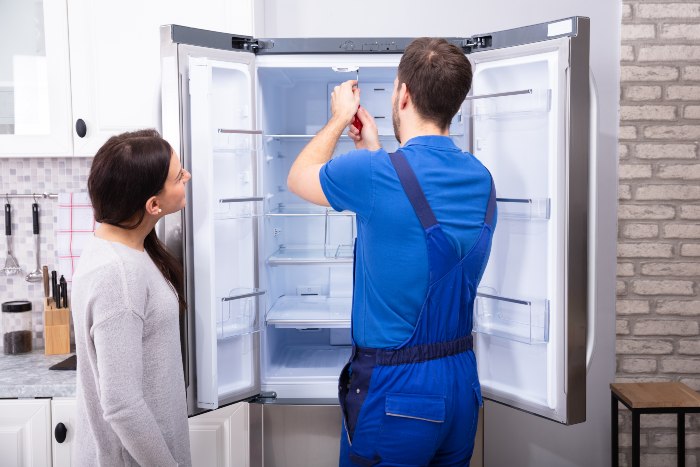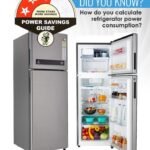Defrost your fridge every six months or when ice build-up exceeds a quarter-inch. Regular maintenance ensures optimal performance.

Maintaining your fridge is crucial for efficiency and longevity. Regular defrosting prevents excessive ice build-up, which can impair the appliance’s performance and increase energy consumption. A well-maintained fridge keeps your food fresh and safe while reducing the risk of unexpected breakdowns.
Defrosting every six months or when ice thickness exceeds a quarter inch ensures your fridge operates smoothly. Regular checks and cleaning also help in identifying potential issues early, saving on costly repairs. Implementing a consistent maintenance routine not only enhances your fridge’s efficiency but also extends its lifespan, making it a cost-effective investment for your household.

Credit: www.acesappliance.com
Importance Of Defrosting
Defrosting your fridge is crucial for its performance. Ice buildup can affect the fridge’s efficiency. Regular defrosting helps keep your appliance running smoothly.
Energy Efficiency
Ice in the fridge makes it work harder. This increases energy usage. A fridge without ice buildup uses less power. This can save you money on energy bills.
Defrosting regularly improves the fridge’s efficiency. It helps the appliance maintain the right temperature. A well-maintained fridge lasts longer.
Food Safety
Ice buildup can affect food storage. It can make the fridge less cold. This can spoil your food faster.
Keeping the fridge defrosted keeps food fresh. It maintains the right temperature for all items. Safe food storage prevents waste and keeps you healthy.
| Benefit | Explanation |
|---|---|
| Energy Efficiency | Less ice means the fridge works less, saving energy. |
| Food Safety | Proper temperature keeps food fresh and safe. |
Signs Your Fridge Needs Defrosting
Defrosting your fridge is essential for its performance and lifespan. Knowing the signs helps keep your fridge working well.
Frost Build-up
One clear sign is frost build-up inside your fridge or freezer. This frost can form on shelves, walls, and around the door. When you see thick ice, it’s time to defrost. Frost build-up reduces space and makes it hard to store food. It also forces your fridge to work harder, using more energy.
Poor Cooling Performance
Poor cooling performance is another key sign. If your fridge isn’t cold enough, it can’t keep your food fresh. You might notice that items take longer to cool. If this happens, check for frost and defrost if needed. Poor cooling can cause food spoilage, costing you money.
| Sign | Effect |
|---|---|
| Frost Build-Up | Less storage space, higher energy use |
| Poor Cooling Performance | Food spoilage, longer cooling times |
- Check for ice on shelves and walls.
- Ensure your fridge is cold enough.
- Defrost when ice gets thick.
- Please turn off your fridge and unplug it.
- Remove all food and shelves.
- Let ice melt naturally or use a bowl of hot water.
- Clean and dry the fridge before turning it back on.
Regular defrosting keeps your fridge running smoothly and efficiently. Look for these signs and act quickly to maintain your fridge.
Recommended Defrosting Frequency
Maintaining your fridge is crucial for its efficiency and lifespan. One important aspect is knowing how often to defrost it. This depends on the type of fridge you have. We’ll explore the recommended defrosting frequency for different types of fridges.
Manual Defrost Fridges
Manual defrost fridges need more attention. Ice builds up faster in these models. You should defrost these fridges every three months. Follow these steps:
- Please turn off the fridge and unplug it.
- Remove all food items.
- Leave the door open to let the ice melt.
- Clean the interior with a mild detergent.
- Dry it completely before plugging back in.
Frost-free Fridges
Frost-free fridges have a self-defrost feature. These models require less manual intervention. Defrosting usually happens automatically. You only need to defrost manually if there is a malfunction. Follow these steps if needed:
- Please turn off the fridge and unplug it.
- Remove all food items.
- Check for any ice buildup.
- Use warm water to melt the ice, if any.
- Clean the interior with a mild detergent.
- Dry it completely before plugging it back in.
Regular maintenance ensures your fridge runs efficiently. Always keep an eye on any unusual ice buildup.

Credit: fridge.com
Steps To Defrost Your Fridge
Defrosting your fridge is essential for its efficiency and longevity. A well-maintained fridge keeps your food fresh and helps you save on energy bills. Here are the steps to defrost your fridge, ensuring you easily perform this task.
Preparation
Before starting the defrosting process, gather the necessary supplies. You will need towels, a bowl, and a sponge. Unplug the fridge to ensure safety. Remove all the food items and store them in a cooler. Take out all shelves and drawers to clean them separately.
Defrosting Process
- Open the fridge door to let warm air in.
- Place towels on the floor to absorb melting ice water.
- Use a bowl to collect water from the defrost drain if available.
- Wait for the ice to melt naturally. This can take several hours.
- For quicker results, place a bowl of hot water inside the fridge.
- Wipe down the interior with a sponge to remove any remaining moisture.
- Clean the shelves and drawers before placing them back.
Once defrosting is complete, plug the fridge back in. Allow it to cool before restocking your food items. Regularly defrosting your fridge helps maintain its efficiency and extends its lifespan.
Tools And Supplies Needed
Knowing how to defrost your fridge is essential for maintenance. Using the right tools and supplies ensures the process is smooth and effective. Below are the essential tools and cleaning supplies needed to defrost your fridge properly.
Essential Tools
- Spatula: Use a plastic spatula to remove ice. Avoid metal spatulas to prevent damage.
- Hairdryer: Speed up the defrosting process with a hairdryer. Be careful to avoid water.
- Large Towels: Place towels around the fridge to absorb water. It keeps your floor dry.
- Cooler: Store your food in a cooler during defrosting. It keeps food safe.
Cleaning Supplies
- Dish Soap: Clean shelves and drawers with mild dish soap. It removes grease and grime.
- Vinegar: Use vinegar for disinfecting surfaces. It kills bacteria and eliminates odors.
- Microfiber Cloths: Wipe down surfaces with microfiber cloths. They are soft and absorbent.
- Baking Soda: Deodorize the fridge with baking soda. It absorbs lingering smells.
Preventing Frost Build-up
Frost build-up in your fridge can cause many issues. It affects your fridge’s efficiency and can spoil food. Preventing frost build-up is essential for maintaining your fridge. Below, we’ll discuss some effective methods.
Proper Storage Practices
How you store food affects frost build-up. Follow these proper storage practices to keep your fridge frost-free.
- Cover all foods to prevent moisture release.
- Keep the fridge door closed as much as possible.
- Do not overfill the fridge; allow air circulation.
- Store liquids in sealed containers to reduce moisture.
Regular Maintenance Tips
Regular maintenance helps in preventing frost build-up. Implement these tips to keep your fridge in top shape.
- Defrost your fridge every 6 months.
- Check door seals for any gaps or cracks.
- Clean the coils behind the fridge to improve efficiency.
- Adjust the temperature settings to avoid freezing.
| Task | Frequency |
|---|---|
| Defrosting | Every 6 months |
| Checking door seals | Monthly |
| Cleaning coils | Every 3 months |
| Adjusting temperature | As needed |
Troubleshooting Common Issues
Even with regular maintenance, fridges can sometimes face issues. Knowing how to troubleshoot common problems can save you time and money. Let’s dive into some frequent issues and their solutions.
Persistent Frost
Persistent frost can be a sign of several problems. Check the door seal first. A damaged seal lets warm air enter, causing frost. Replace any faulty seals immediately.
Another cause could be the defrost thermostat. If it’s not working, it won’t regulate the temperature properly. Use a multimeter to test it. Replace it if it’s faulty.
Also, inspect the defrost heater. This part melts any frost that forms. If it’s broken, frost will build up. Test it with a multimeter and replace it if needed.
Water Leakage
Water leakage inside or outside the fridge can cause a mess. First, check the drain pan. If it’s full or damaged, it can overflow. Empty or replace it if necessary.
Next, inspect the drain hole. It can get clogged with food particles or ice. Use a pipe cleaner to unclog it.
Sometimes, the water filter might be the issue. A blocked filter can cause leaks. Replace the water filter every six months.
Troubleshooting these common issues can extend your fridge’s life. Regular maintenance keeps your appliance running smoothly.
When To Call A Professional
Sometimes, defrosting your fridge is not enough. Issues may arise that need a professional touch. Knowing when to call an expert can save time and prevent further damage.
Complex Repairs
Some fridge issues are too complex for DIY solutions. If the fridge is leaking, making strange noises, or not cooling properly, call a technician. They have the tools and skills to fix the problem.
If the compressor or motor is faulty, contacting a professional is best. These parts are crucial for the fridge’s operation and require expert handling.
Safety Concerns
Fridge repairs can involve electrical components. If you are unfamiliar with electrical work, it is safer to call a professional. Mishandling electrical parts can lead to shocks or fires.
Gas leaks from the fridge’s coolant system are another safety concern. If you smell gas or notice a drop in cooling, contact a technician immediately. They can safely handle and fix coolant issues.
| Signs | Action |
|---|---|
| Leaking water | Call a Professional |
| Strange noises | Contact a technician |
| Not cooling properly | Seek expert help |
| Electrical issues | Get professional assistance |
| Gas leaks | Call a technician immediately |
- Leaking water: This could indicate a blocked drain or other issue.
- Strange noises: These could be signs of a failing motor.
- Not cooling properly: This could mean a problem with the compressor.
- Electrical issues: These are best handled by a professional.
- Gas leaks: These are dangerous and need immediate attention.

Credit: www.facebook.com
Frequently Asked Questions
How Often Should You Defrost a Fridge?
Defrost your fridge every six months to maintain efficiency. If frost buildup is excessive, defrost it sooner. This helps keep your fridge running smoothly and extends its lifespan. Regular defrosting also improves energy efficiency, saving you money on electricity bills.
How Often Does A Refrigerator Need Maintenance?
A refrigerator needs maintenance every 6 to 12 months. Regular cleaning and inspection ensure optimal performance.
What Happens if You Don’t Defrost Your Fridge?
Ice buildup reduces cooling efficiency and increases energy consumption. Food may spoil faster, and the fridge might malfunction. Defrost regularly to avoid these issues.
How Often Should a Fridge Freezer Be Serviced?
Service your fridge freezer annually. Regular maintenance ensures efficiency and prevents costly repairs. Clean coils and check seals.
Conclusion
Regularly defrosting your fridge ensures optimal performance and extends its lifespan. Aim to defrost every three to six months. This simple maintenance step prevents frost buildup and keeps your food fresh. Consistent care minimizes energy consumption and helps avoid costly repairs.
Keep your fridge in top shape with these easy guidelines.


GIPHY App Key not set. Please check settings